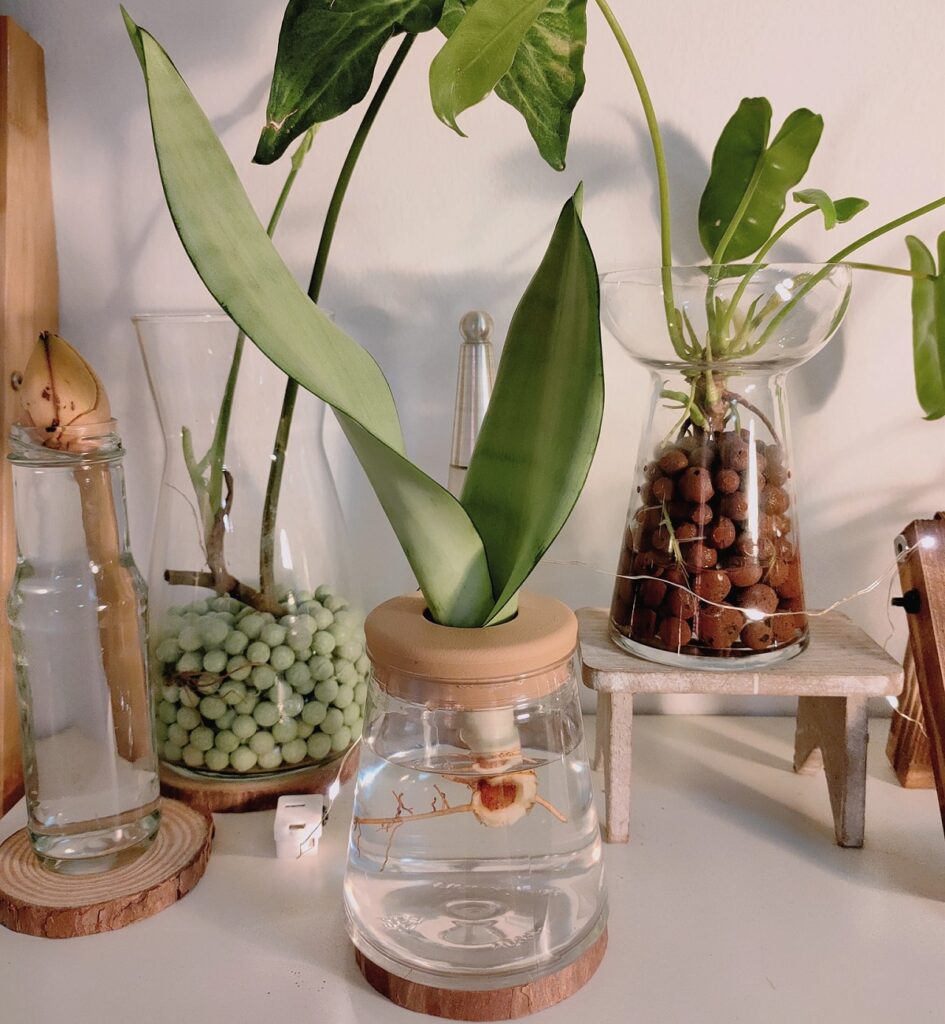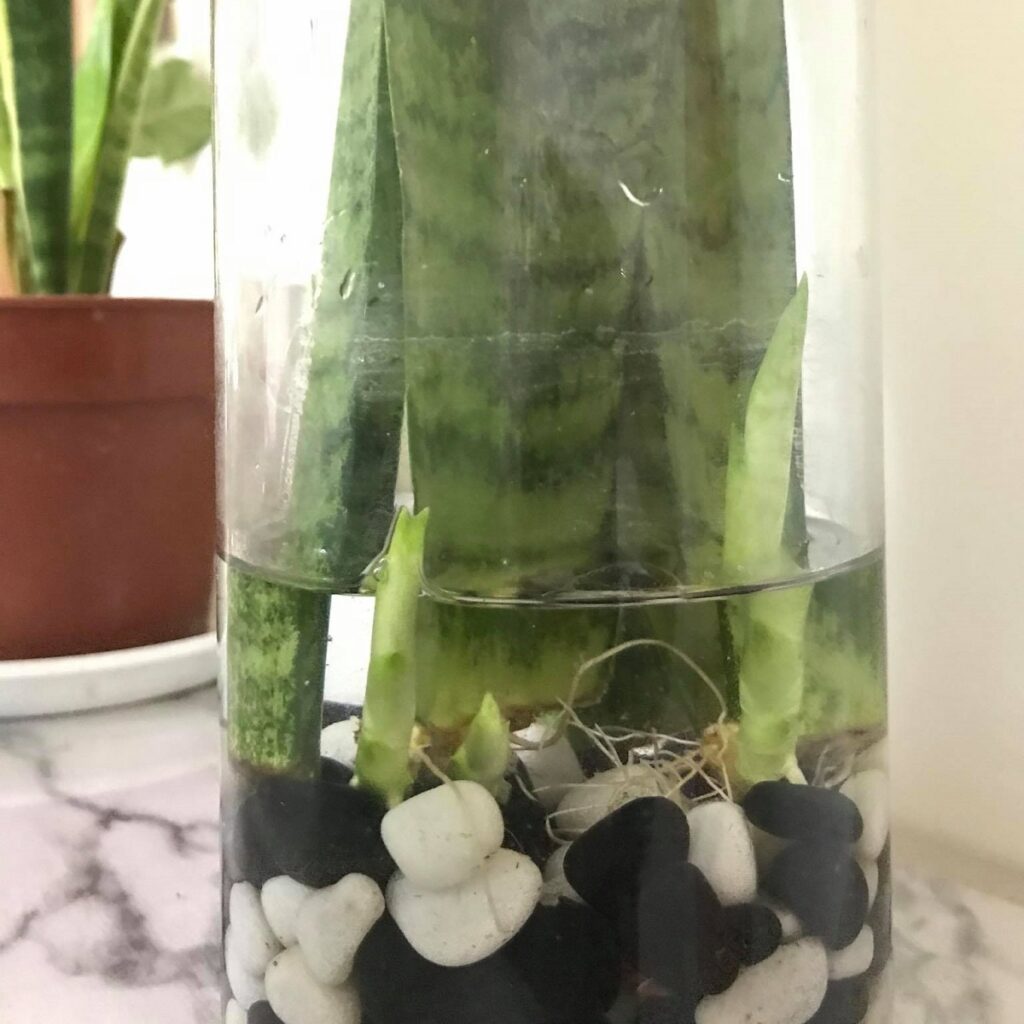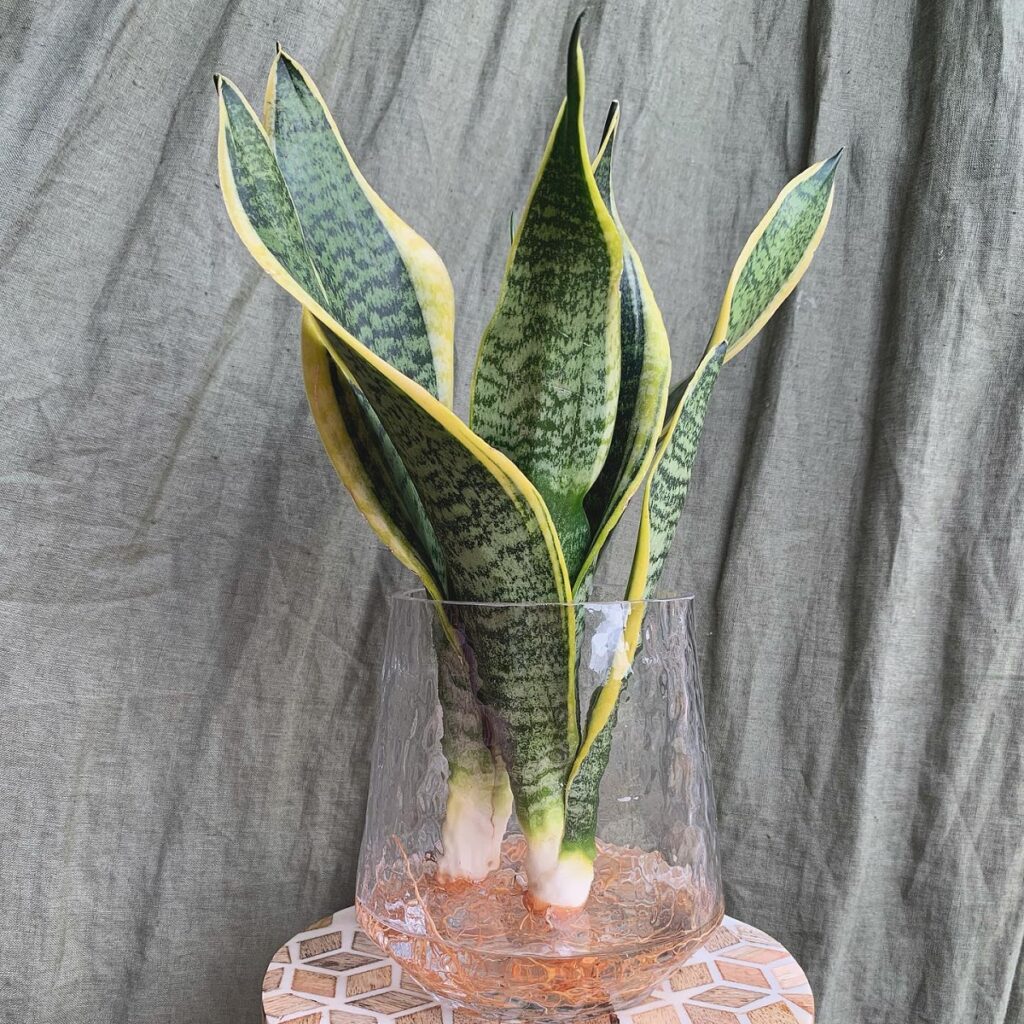Welcome to the wonderful world of growing snake plants in water! This amazing and easy process will take your home decor game to a whole new level. Not only are these plants low-maintenance and require minimal effort on your part, but they also look absolutely stunning when done right. With just a few simple steps you’ll have yourself a beautiful plant that can last for years with proper care.

Ready to get started? Growing snake plants in water is easier than it looks—all you need is some time, patience, and know-how. In this article, I’m going to walk you through every single step so there’s no guessing or wondering involved. From choosing the right container size to deciding which type of water to use, I’ve got everything covered for ya!
So let’s dive into this journey together and start learning how to grow your very own snake plant in water at home. Get ready for an adventure like never before—once you see the result of your labor, you’ll be hooked forever!
Contents
Can A Snake Plant Survive Without Soil?
Yes, it’s possible for snake plants to survive without soil! In fact, they can be propagated and grown in water. Water propagation is a simple and effective way of growing your own snake plants from leaf cuttings.
To do this, you’ll need to start with clean water—tap water that has been allowed to sit out overnight works best. Once the water has reached room temperature, add a liquid fertilizer or plant tonic of your choice. Then take some healthy leaves from an adult snake plant and put them into the container with the prepared water.
You should see new roots form within 4-6 weeks if all goes well. Finally, when the roots are established and at least two inches long, transfer the rooted cutting into its new soil home where it will continue to grow healthily over time.

Why Do Snake Plants Rot In Overwatered Soil But Not In Just Water?
Transitioning from the previous section, snake plants can be grown in water and soil. But how do they fare when it comes to overwatering? It’s a common concern for those looking to grow their plant using just water as opposed to soil and is important to understand why snake plants rot in overly watered soils but not in pure water.
When snake plants are grown in soil, excess water can accumulate in the soil, leading to waterlogged conditions. The roots can then become damaged and start to rot. On the other hand, when snake plants are grown in water, they are less likely to experience root rot because the water is continually refreshed, and excess water can easily drain away.
Snake plants grown in water can also benefit from the added oxygen in the water, which can promote healthy root growth. However, it’s essential to ensure that the water is changed regularly and that the plant is not left sitting in stagnant water for too long, as this can lead to other problems such as bacterial growth and nutrient deficiencies.
Benefits Of Growing Snake Plants In Water

Growing snake plants in water has significant benefits, including:
- Better Drainage: Snake plants are prone to root rot if they sit in waterlogged soil for too long. Growing them in water allows for better drainage, ensuring that the roots don’t become waterlogged and preventing the development of root rot.
- Easier Maintenance: Growing snake plants in water is relatively low maintenance. Since there’s no dirt involved here, there’s less worry about pests or diseases infecting your plant since most of those thrive when living in moist soil conditions.
- No risk of over-watering: Simply replace and top up the container with clean water whenever needed.
- Improved Air Quality: Snake plants are known for their air-purifying properties. Growing them in water can help them to remove toxins and pollutants from the air, improving the air quality in your home.
- Promotes Healthy Growth: Growing snake plants in water can promote healthy root growth. The roots are able to absorb oxygen directly from the water, which can promote the growth of new roots and keep the plant healthy.
- Aesthetic Appeal: Growing snake plants in water can be aesthetically pleasing. The roots of the plant are visible in the water, and the plant can create a unique and eye-catching centerpiece in any room.
How To Grow Snake Plant In Water
Propagating Snake Plants In Water
If you have ever wanted to learn how to propagate snake plants in water, leaf propagation is a great way to do it. It’s an easy project that will provide you with beautiful variegated leaves for your home or garden! Here are the steps you need to take:
- Choose a healthy snake plant leaf to propagate. Make sure the leaf is green and healthy, without any signs of disease.
- Cut off the leaf at the base, just above where it attaches to the stem. You can also cut the leaf horizontally into multiple 3-inch sections (optional). Let the leaf sit for a few days so that the cut end can dry and callous over. This will help prevent rot when it’s in the water.
- Fill a glass or jar with clean, room-temperature water. Place the leaf cutting in the water, making sure the bottom cut end is submerged. Place the jar in a warm, bright spot, but not in direct sunlight.
- Change the water every few days to keep it fresh. After a few weeks, you should start to see roots and new plantlets forming. Once the roots are a few inches long, you can transplant the leaf cuttings into soil.

Enjoy your new snake plant babies!
Migrating Snake Plant From Soil To Water
Migrating a snake plant from soil to water is a relatively simple process, and it can be a great way to improve the health of your plant. Here are the steps you’ll need to follow:
1. Prepare the container
Choose a container that’s large enough to hold your plant and fill it with clean, room-temperature water. You can use tap water, but it’s a good idea to let it sit for a few hours before using it to allow any chlorine to dissipate. You can also add some aquarium charcoal to the water to keep it fresh and clean.
2. Remove the plant from the soil
Gently remove the snake plant from its pot, being careful not to damage the roots. Use your fingers to remove as much soil as possible, but don’t worry if some of it remains.
3. Rinse the roots
Place the plant under running water and rinse the roots thoroughly to remove any remaining soil. Use your fingers to gently remove any stubborn bits of soil.
4. Place the plant in water
Place the plant in the container of water, making sure that the roots are fully submerged. You may need to use rocks or other materials to anchor the plant in place.

5. Place the container in a bright spot
Place the container in a bright spot, but avoid placing it in direct sunlight, as this can cause the water to heat up and damage the plant. You may also want to add some liquid fertilizer to the water every month or so to provide the plant with nutrients.
6. Change the water regularly
Change the water every two to four weeks, making sure to clean the container thoroughly before adding fresh water. This will help to keep the water fresh and prevent the growth of bacteria and algae.
Now that your snake plant has been transferred to its water-based home, you will want to monitor it closely over time to ensure proper growth and nutrition. Keep an eye out for discoloration or wilting, both signs that something isn’t quite right with your newly potted friend! If these symptoms occur frequently, then consider testing different amounts of fertilizer or changing out old water so that your snake plant can stay happy and healthy.
Frequently Asked Questions
How Long Does It Take To Propagate Snake Plant In Water?
Propagating a snake plant in water is relatively easy and it won’t take too long to get the desired results. Depending on several factors, such as temperature, humidity, light levels, etc., it can take between one to three months for the process to be completed.
Related Post:
How Fast Do Snake Plants Grow?
Why Is My Snake Plant Not Growing Roots In Water?
It is possible that your snake plant is not growing roots in the water because of environmental factors. First off, the water may not have enough oxygen. If the water is not oxygenated properly, the roots of the snake plant will not be able to absorb the oxygen they need to grow. Additionally, the temperature of the water may be too low for the roots to grow. If the water is too cold, it can inhibit the root growth of the snake plant.
The amount of sunlight the snake plant is receiving could also be a factor. Too much direct sunlight can cause the plant to become stressed, which can affect its ability to grow roots. It is also possible that the water is not nutrient-rich enough for the plant to absorb the nutrients it needs for root growth. You should ensure that the water contains the necessary minerals and nutrients for the snake plant to thrive.
Finally, switch out the water every few days or so—don’t let it sit stagnant in the container over long periods of time! Doing this regularly helps keep bacteria and other potential contaminants away from your precious new root system while providing an abundance of oxygenated liquid gold for those roots to thrive off of!
How Long Should I Leave My Snake Plant In Water?
When propagating a snake plant, it’s important to leave your cutting in water for long enough for roots to form. Generally, you should leave your cutting in water for about three to six weeks before transplanting it into soil. During this time, it’s important to check the water level periodically and replace the water with fresh water if necessary. Additionally, you should make sure the container of water is in a warm and well-lit area, as this will help with root growth.
Once you see roots forming, it’s a good idea to begin gradually introducing your cutting to soil by transferring it to a pot with soil and water. Monitor the development of the roots, and once they are well established, you can transplant the cutting into a pot with fresh soil. However, it’s important to keep in mind that the success of your snake plant propagation will depend on the environment and the care you provide. Be sure to provide plenty of indirect sunlight, regular watering, and adequate drainage. With proper care, you should be able to successfully propagate and maintain a healthy snake plant!
Is It Better To Propagate Snake Plant In Water Or Soil?
I’ve heard the debate about propagating snake plants in water or soil, and there’s no one-size-fits-all answer. It really depends on your preference and how you want to grow it. If done correctly, both methods will keep your plant happy!
Propagating in water is a simpler and quicker process, as the cuttings don’t require any soil and can be placed directly in a jar of water. However, propagating in soil is also an option that produces more traditional results. When propagating in soil, the cuttings should be placed in a well-draining potting mix and kept in a warm spot with indirect sunlight. After the roots have formed, the snake plant can be transplanted into a larger pot. Both methods of propagation can be successful, so it is really a matter of personal preference.
It is important to note that regardless of the propagation method, snake plants are very hardy and easy to care for. Once the plant has been propagated and established, it should be watered sparingly and given bright, indirect sunlight. With proper care, the snake plant will continue to thrive and eventually produce new shoots.
Why Is My Snake Plant Dying In Water?
So you’ve been caring for your snake plant in water and it seems to be weakening or even dying. This can be very disheartening, especially if you’ve put a lot of time into it! There are a few possible reasons why this could be happening.
1. Water Quality
Poor water quality can be a significant issue for snake plants grown in water. If the water is contaminated with chemicals or bacteria, it can cause the roots to rot or prevent the plant from getting the nutrients it needs. Be sure to use clean, room-temperature water and change it every two to four weeks to keep it fresh.
2. Lack of Light
While snake plants can tolerate low light conditions, they still need some light to grow and thrive. If your plant is not getting enough light, it may start to wilt or turn yellow. Try moving it to a brighter spot, but avoid placing it in direct sunlight, as this can cause the water to heat up and damage the plant.
3. Overfertilization
Overfertilizing your snake plant can be just as harmful as under-fertilizing it. If you are adding too much fertilizer to the water, it can cause the water to be very concentrated and burn the plant’s roots. Scale back on the amount of fertilizer you are using and only add it every month or so when you change the water.
4. Root Rot
Root rot is a common problem for snake plants grown in water. It can occur when the roots are submerged in water for too long and become waterlogged. Signs of root rot include yellow or brown leaves, mushy roots, and a foul smell. If you suspect your plant has root rot, you may need to remove it from the water, cut away any damaged roots, and replant it in fresh water.
5. Temperature Changes
Changes in temperature can also be harmful to snake plants grown in water. If the water becomes too cold or too hot, it can stress the plant and cause the leaves to turn yellow or brown. Keep the plant in a stable, room-temperature environment, and avoid placing it near heaters or air conditioning vents.
Remember, every plant is different, and it may take some trial and error to figure out what is causing your snake plant to die in water. If you’re not sure what’s wrong, try adjusting the water quality, light, or fertilizer levels to see if that helps.
Conclusion
Growing snake plants in water can be a great way to add greenery to your home environment. It’s easy and requires minimal effort, plus the added bonus of being able to propagate new growth quickly. If you’ve decided that growing snake plants in water is for you, it’s important to understand how to properly care for them so they will grow healthy and strong.
If things don’t seem to go according to plan, take a step back and investigate what might be going wrong. Common issues may include incorrect watering habits, transitioning from soil incorrectly or even just bad luck—but whatever it is, understanding the issue can help you better address it moving forward.
Overall, growing snake plants in water can be an enjoyable experience that yields beautiful results when done correctly. Keep all of the above information in mind and use trial and error until you find a method that works best for both you and your plant!
